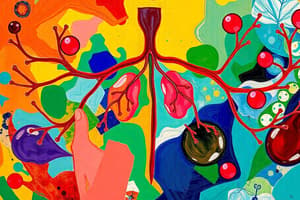Podcast
Questions and Answers
What phenomenon describes a decreased number of receptors in response to abnormally high hormone levels?
What phenomenon describes a decreased number of receptors in response to abnormally high hormone levels?
Which condition is characterized by increased cortisol levels due to low CRH and ACTH?
Which condition is characterized by increased cortisol levels due to low CRH and ACTH?
In secondary hypothyroidism, what are the characteristic hormone levels?
In secondary hypothyroidism, what are the characteristic hormone levels?
What is the role of albumins in the blood?
What is the role of albumins in the blood?
Signup and view all the answers
What does primary hypocortisolism indicate about hormone levels?
What does primary hypocortisolism indicate about hormone levels?
Signup and view all the answers
Which of the following conditions involves high levels of CRH, ACTH, and cortisol?
Which of the following conditions involves high levels of CRH, ACTH, and cortisol?
Signup and view all the answers
Which component makes up approximately 7% of the fluid matrix of blood?
Which component makes up approximately 7% of the fluid matrix of blood?
Signup and view all the answers
What is fibrinogen responsible for in the blood?
What is fibrinogen responsible for in the blood?
Signup and view all the answers
What is a characteristic of secondary hypercortisolism?
What is a characteristic of secondary hypercortisolism?
Signup and view all the answers
Which pathway results in primary hyperthyroidism?
Which pathway results in primary hyperthyroidism?
Signup and view all the answers
In tertiary hypercortisolism, what are the expected levels of CRH, ACTH, and cortisol?
In tertiary hypercortisolism, what are the expected levels of CRH, ACTH, and cortisol?
Signup and view all the answers
What characterizes primary hypocortisolism in terms of hormone levels?
What characterizes primary hypocortisolism in terms of hormone levels?
Signup and view all the answers
Which blood protein is primarily responsible for osmotic pressure?
Which blood protein is primarily responsible for osmotic pressure?
Signup and view all the answers
Secondary hypothyroidism is associated with which of the following hormone levels?
Secondary hypothyroidism is associated with which of the following hormone levels?
Signup and view all the answers
Which hormone levels are found in primary hypercortisolism?
Which hormone levels are found in primary hypercortisolism?
Signup and view all the answers
What defines the tertiary dysfunction in terms of hormone production?
What defines the tertiary dysfunction in terms of hormone production?
Signup and view all the answers
Study Notes
Downregulation
- Decreased number of receptors in response to high hormone levels
- Caused by the last endocrine gland in the pathway (e.g., Graves' disease, Addison's disease)
- Or due to pituitary (or hypothalamus) issues
Hormone Regulation (Examples)
- Primary hypercortisolism: Low CRH, low ACTH, high cortisol; low CRH, high ACTH, high cortisol; high CRH, high ACTH, high cortisol; high CRH, high ACTH, low cortisol
- Primary hypocortisolism: low TRH, low TSH, high T3T4; low TRH, high TSH, high T3T4; high TRH, high TSH, high T3T4; high TRH, low TSH, low T3T4
Fluid Matrix of Blood
- Primarily water (~92%)
- Proteins (~7%)
- Other substances (~1%)
Blood Proteins
- Albumins: Osmotic pressure
- Globulins: Clotting factors
- Fibrinogen: Forms fibrin threads (blood clotting)
- Transferrin: Iron transport
Blood Cells
- Erythrocytes (RBCs): Mature RBCs, platelets, leukocytes, lymphocytes, monocytes, neutrophils, eosinophils, basophils
- Thrombocytes (platelets): Involved in blood clotting (fibrinogen to fibrin)
- White blood cells (WBCs): Immune cells, phagocytes (macrophages), mobile phagocytes, produce toxic compounds against pathogens
- Lymphocytes
- Monocytes
- Neutrophils
- Eosinophils
- Basophils
- Leukopoiesis: Production of WBCs
- Thrombopoietin: Regulates platelet production
- Hematoct: Ratio of RBCs to plasma (40-54% in males, 37-47% in females)
- Hemoglobin: Reflects oxygen carrying capacity (14-17 in males, 12-16 in females)
- Total WBC count: 4-11 x 10^3 cells/microliter (both sexes). (neutrophils 50-70%, eosinophils 1-4%, basophils <1%, lymphocytes 20-40%, monocytes 2-8%)
RBC Function
- Energy production: Anaerobic glycolysis
- Iron per hemoglobin: 4
- Lifespan: 120 days, destroyed in spleen
Hemostasis
- Preventing blood loss: Vasoconstriction, platelet plug, coagulation
Blood Vessel Function
- Continuous capillaries: Leaky, allow small molecules and water to pass
- Fenestrated capillaries: Pores in vessel wall; found in kidneys, intestines, and endocrine glands; allow passage of large molecules
- Capillary exchange: Primarily through simple diffusion (small) and transcytosis (larger). Capillary filtration is caused by hydrostatic pressure, and capillary absorption is caused by osmotic pressure.
- Lymphatic tissue: Returns fluid and proteins to the circulatory system. Filters pathogens.
- T cells: Originate in the thymus.
Studying That Suits You
Use AI to generate personalized quizzes and flashcards to suit your learning preferences.
Related Documents
Description
This quiz covers key concepts related to hormone regulation, the fluid matrix of blood, and the various types of blood cells and proteins. It emphasizes the mechanisms of hormone action and the physiological roles of blood components. Perfect for students studying the endocrine system and hematology.




